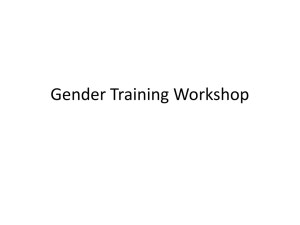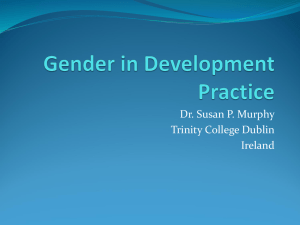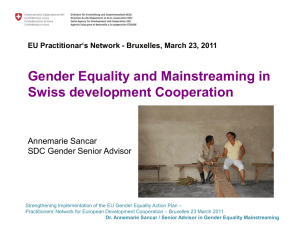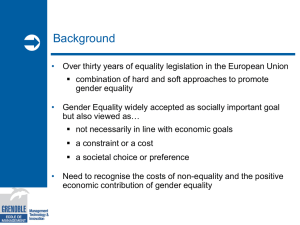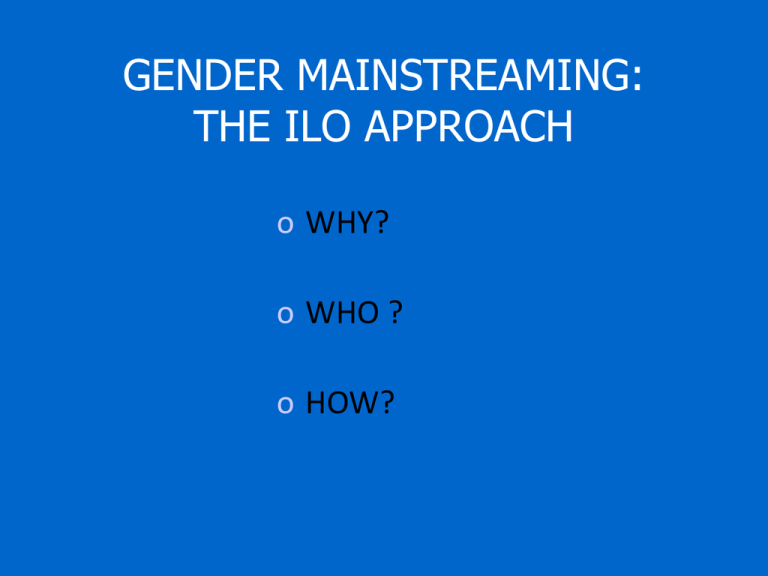
GENDER MAINSTREAMING:
THE ILO APPROACH
o WHY?
o WHO ?
o HOW?
WHY ?
ILO Declaration of Philadelphia,
1944
“Every human being, irrespective of
race, creed, sex, or religion, has the
right to pursue both his material
well-being and spiritual development
in conditions of freedom, dignity and
equal opportunity...”
WHY?
ILO DG Circular on Gender Equality and
Mainstreaming, 1999
“The ILO must now work to ensure that
commitment to gender equality is
internalized throughout the Organisation
and reflected in all our technical work,
operational activities, support services.”
WHY?
TO WORK MORE
PROFESSIONALLY
WHO?
“The implementation of this gender equality
and mainstreaming policy requires the
unfailing commitment, participation and
contribution
of each staff member”
ILO Director- General Announcement No. 564
17.12.1999
WHO?
“ Every individual staff member * (should be)
fully gender sensitized, trained in the use
of specific gender techniques, motivated in
pursuing gender equality as a main goal”
*
Project Managers and Officers, Assistants,
Support Staff, Directors…
“Our” Gender Approach
International
Labour
Standards
Applying gender
methodologies to
project/programme
design
Looking for gender
disaggregated data
Gender
sensitive
implementation
Improving the
institutional
knowledge-base
Measuring impact
on women and men
Focusing
on basic
principles
HOW?
Learning how to use a set of
appropriate tools
HOW?
Legal tools
(international
standards)
Focusing on basic
principles
Statistical tools
Looking for genderdisaggregated data
Methodological tools
Applying gender
methodologies
HOW?
Specific networks and
contacts
Gender-sensitive
reference materials
(data, cases, training
materials…)
Gender sensitive
implementation
Improving the
institutional
knowledge –base
HOW?
Evaluation tools
Measuring the
impact on men
and women
GENDER MAINSTREAMING: best practices
•
•
•
•
•
•
•
•
•
Gender analysis/stakeholder analysis
Gender needs assessment
Gender planning
Gender-specific action
Capacity building on gender equality
Gender sensitive monitoring & evaluation
Relevant gender expertise
Adequate resources
Knowledge sharing on gender mainstreaming
GENDER MAINSTREAMING
In July 1997, the United Nations Economic and Social Council (ECOSOC)
defined the concept of gender mainstreaming as follows:
“Mainstreaming a gender perspective is the process of assessing the implications
for women and men of any planned action, including legislation, policies or
programmes, in any area and at all levels.
It is a strategy for making the concerns and experiences of women as well as of
men an integral part of the design, implementation, monitoring and evaluation of
policies and programmes in all political, economic and societal spheres, so that
women and men benefit equally, and inequality is not perpetuated.
The ultimate goal of mainstreaming is to achieve gender equality.”
Introduction
Introduction
Introduction
Overview
Overview
Building
Building Blocks
Blocks
Summary
Summary
GENDER MAINSTREAMING
IN PRACTICE
Within its technical cooperation programme, the ILO has piloted ways to
promote gender mainstreaming through a two-pronged approach, including:
• All projects/programmes should aim to systematically address the
concerns of both women and men through gender analysis and
planning.
• Targeted interventions should be designed to enable women and men to
participate equally in, and benefit equally from, development efforts.
Introduction
Introduction
Introduction
Overview
Overview
Building
Building Blocks
Blocks
Summary
Summary
GENDER MAINSTREAMING
IN ILO TECHNICAL COOPERATION PROJECTS
As an applied strategy, gender mainstreaming in technical cooperation projects
entails:
• Involving both women and men beneficiaries in consultations and analysis;
• Including sex-disaggregated data in the background analysis and justification;
• Formulating gender-sensitive strategies and objectives, and corresponding genderspecific indicators, outputs and activities;
• Striving for gender balance in the recruitment of project personnel and experts and
in representation in institutional structures set up under the projects;
• Including impact assessment on gender equality in evaluations as well as gender
expertise in the evaluation team.
Introduction
Introduction
Introduction
Overview
Overview
Building
Building Blocks
Blocks
Summary
Summary
Building Blocks of a
Gender Mainstreaming Strategy
Good practice elements:
•
•
•
•
•
•
•
•
•
Gender analysis/stakeholder analysis
Gender needs assessment
Gender planning
Gender-specific action
Capacity building on gender equality
Gender sensitive monitoring & evaluation
Relevant gender expertise
Adequate resources
Knowledge sharing on gender mainstreaming
Introduction
Introduction
Introduction
Overview
Overview
Building
Building Blocks
Blocks
Summary
Summary
GENDER ANALYSIS
•
Gender analysis can be undertaken at any stage during the project cycle, but it is
proving most effective if included at the initial planning and design stages.
•
Gender analysis is a tool for identifying the different roles and needs of women
and men in a given context and project setting.
•
In the world of work, a gender analysis includes looking at:
– The division of labour between women and men;
– The different needs of women and men in the world of work;
– The sex-based division of access to, and control over, resources and benefits;
– Opportunities and constraints in the social and economic environment;
– The capacity of ILO constituents and other partner organisations to promote
equality between women and men in employment.
Introduction
Introduction
Overview
Overview
Building
Building Blocks
Blocks
Summary
Summary
GENDER NEEDS ASSESSMENT
•
Gender needs assessment is closely linked to the concept of gender
analysis: they are both valuable analytical tools for strengthening a project’s
potential to meet the different needs and interests of women and men
throughout the project cycle.
•
A gender needs assessment sheds light on both practical and strategic
gender needs:
– Practical gender needs are needs that, once met, enable women and
men to maintain their existing positions in society.
– Strategic gender needs, on the other hand, once met, transform these
positions and subsequently alter power relations between women and
men.
Introduction
Introduction
Overview
Overview
Building
Building Blocks
Blocks
Summary
Summary
GENDER PLANNING
•
The findings of the gender analysis and needs assessment should be used to
inform strategic planning of any project interventions.
•
Gender planning consists of developing a strategy which describes how
gender equality will be promoted in project activities through specific
measures and organisational arrangements such as:
– Committing to balanced representation of women and men in
project activities;
– Ensuring that adequate resources and expertise are available.
Introduction
Introduction
Overview
Overview
Building
Building Blocks
Blocks
Summary
Summary
GENDER-SPECIFIC ACTION
•
Gender-specific action can be defined as action which is adopted to redress
gender-based inequalities and discrimination against women and/or men in
a given context.
•
The ILO recognises that if historically entrenched discrimination against
women in the world of work is to be tackled, specific action in favour of
women could be required. Hence, the ILO promotes, when necessary, the
use of gender-specific policy action to achieve such aims.
During a project’s gender planning stage, it can be proposed that
the project includes such action (directed at either women or men)
to redress gender inequalities.
Introduction
Introduction
Overview
Overview
Building
Building Blocks
Blocks
Summary
Summary
CAPACITY BUILDING ON GENDER EQUALITY
•
Building capacity for gender mainstreaming amongst project staff and
beneficiaries is essential for ensuring that gender analysis and planning are
applied throughout the project cycle and used to inform project activities.
•
Capacity building could focus on:
– Clarifying key gender concepts;
– Understanding the process and role of gender analysis;
– Providing practical guidance on how to undertake gender
for project and programme activities.
Introduction
Introduction
Overview
Overview
Building
Building Blocks
Blocks
planning
Summary
Summary
GENDER-SENSITIVE MONITORING AND EVALUATION
• Monitoring and evaluation are important processes for reviewing the
extent to which projects are addressing key gender issues, including
progress towards equal access to education, training and decent
employment.
• In order for monitoring and evaluation to be gender-sensitive, it is
crucial that relevant gender-sensitive indicators are integrated into the
project design and that they in turn are integrated into the monitoring
and evaluation guidelines and terms of reference.
The gender analysis and planning processes are key stages
developing gender-sensitive indicators.
Introduction
Introduction
Overview
Overview
Building
Building Blocks
Blocks
Summary
Summary
for
KNOWLEDGE SHARING ON GENDER MAINSTREAMING
•
Knowledge sharing is a process which begins by capturing and organising
knowledge and experience, and then proceeds to make this knowledge
accessible to a wider audience – thus cultivating new linkages between
interested groups.
“Good practices” and “lessons learnt” are valuable sources
knowledge, as they enable project staff to learn from the
experiences of other projects and apply them in their own
•
of
work.
Knowledge sharing of the different approaches used to promote gender
equality in ILO’s technical cooperation activities allows the entire
Organization to capitalise on those experiences.
Introduction
Introduction
Overview
Overview
Building
Building Blocks
Blocks
Summary
Summary
RELEVANT GENDER EXPERTISE
•
The need to attract relevant gender expertise – in order to systematically
implement the various elements of a strategy promoting gender equality – cuts
across all of the above mentioned building blocks.
•
Establishing linkages with gender expertise can facilitate promotional and
advocacy work on gender equality through project activities as well as technical
support and advice to ILO staff and constituents on ways to mainstream gender
into the project cycle and thus promote gender equality in the world of work.
•
The above approach can be very useful, especially when technical activities are
centred on the promotion of the ILO’s key equality Conventions:
o No. 100 on Equal Remuneration, 1951;
o No. 111 on Discrimination (Employment and Occupation), 1958;
o No. 156 on Workers with Family Responsibilities, 1981;
o No. 183 on Maternity Protection Convention, 2000.
Introduction
Introduction
Overview
Overview
Building
Building Blocks
Blocks
Summary
Summary
ADEQUATE RESOURCES
Like gender expertise, sufficient resources are essential to
implement the various building blocks of a mainstreaming strategy
promoting gender equality.
This is not to say that gender mainstreaming will necessarily require
vast amounts of resources, but rather an affirmation that the above
elements require strategic commitment, in terms of human
resources and budgets, in order to be implemented successfully.
Introduction
Overview
Building Blocks
Summary
SUMMARY:
Gender mainstreaming in the programming cycle
Knowledge sharing
Gender-analysis/
Needs assessment
Gender expertise
Gender-sensitive
monitoring/evaluation
Adequate resources
(financial / Human)
Gender planning
Gender-specific action/
Capacity building
Introduction
Introduction
Overview
Overview
Building
Building Blocks
Blocks
Summary
Summary
REFERENCES
This presentation is based on the publication:
Good Practices in Promoting Gender Equality in ILO Technical Cooperation Projects,
published by the ILO Bureau for Gender Equality, 2007
To receive a copy of the publication and for more information on the cited projects,
please contact the Bureau for Gender Equality, gender@ilo.org or the Gender and
Non-Discrimination Programme of ITC/ILO (Turin): gcu@itcilo.org
Introduction
Introduction
Overview
Overview
Building
Building Blocks
Blocks
Summary
Summary
Gender equality in the economy
in the Middle East and North Africa:
general trends
Education, life expectancy,
pro-capita income
---> Positive trend
Economic participation,
political empowerment ---> Low, compared
to other regions
Gender equality in the economy
in the Middle East and North Africa:
general trends
Need for a better / more productive use of
non-oil resources = human talents
both male and female
Gender equality in the economy
in the Middle East and North Africa:
general trends
As an average: 1 employed person supports
more than 2 non-working dependants
Highest ratio in the world
Gender equality in the economy
in the Middle East and North Africa:
general trends
Large investments in education
but
Low return in economic participation
Higher female participation is supposed to be
able to boost household earnings by 25%
Gender equality in the economy
in the Middle East and North Africa:
general trends
Economic slowdown causes a preference for men in
employment (“they are the breadwinners”)
Resource-rich countries have lower levels of female
participation in the economy (in condition of
unemployment men are hired first and foremost)
Gender equality in the economy
in the Middle East and North Africa:
general trends
Culturally, public sectors jobs are considered
more suitable for women.
If public sector shrinks = less female
employment
Gender equality in the economy
in the Middle East and North Africa:
general trends
Typical gender roles:
• Focus on the family, not on the individual.
• Man as a breadwinner
• Modesty code for women limits interactions
out of the family sphere
• Family laws dictate unequal balance of power
(in the household and in the society)
Gender equality in the economy
in the Middle East and North Africa:
general trends
•
•
General biases to women participation in the
labour market:
Tax and employment-related benefits geared
towards men.
Women considered as less flexible (hours of
work / mobility)
A NEW GENDER AGENDA
• Review of the legislative environment
• Supportive infrastructure
• Continued attention to education, +
vocational training and life-long learning
• Reform of labour regulations with a view to
enhancing employment in the private sector
A NEW GENDER AGENDA
In three group, critically discuss the hand-out (with
particular reference to the last section “A new gender
agenda”) and answer to the following questions:
a)
b)
c)
d)
Would the four proposed policy areas be applicable in your
country?
Which other policies would enhance women’s participation
in the economy?
Please identify indicators that could help policy makers in
shaping and implementing these policies (both a) and b)).
Are there statistical sources to supply data for such
indicators?

